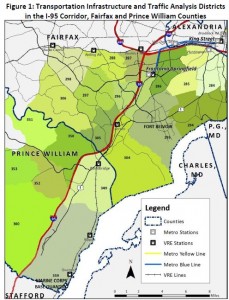Traffic flow in the Interstate 95 corridor in Northern Virginia has improved since completion of the “Mixing Bowl” project (at the intersection with the Interstate 495 Capital Beltway) and travelers could see even more improvements when the I-95 express lane projects open for service. But several sections of I-95 still will operate at failing levels of service, while continued population and job growth in the corridor will keep the transportation infrastructure under continued stress.
So concludes a new report, “Outlook for the I-95 Corridor in Fairfax and Prince William Counties,” by David E. Versel, senior research associate at George Mason University’s Center for Regional Analysis.
The population along the 21-mile area under study amounted to 566,000 in 2010. The highway segment is one of the most heavily congested stretches of interstate in the United States; the arterials and collector roads feeding the interstate are highly congested as well. Metro, Virginia Railway Express (VRE) and local bus services carry roughly 27,000 riders daily but there is no easy way to add new capacity. Meanwhile, carpooling is declining, “likely due to a shift away from the historic model of large numbers of Federal employees who travel to the same destinations each day.” With the VRE already operating on a “standing room only” basis, there isn’t any slack in the rail system. Yet populations forecasts anticipate growth to 692,000 by 2030.
So, what do we do about it? While Versel sketches the challenges facing this critical region, he doesn’t offer much in the way of remedies. Such was not his aim. But the question remains, how does the region, already teetering on the edge of transportation dysfunction, absorb 125,000 more inhabitants in an era of chronically constrained state and local-government resources?
A couple of observations… First, a huge number of workers are commuting to jobs in Arlington, Alexandria and Washington, D.C. In other words, the total lack of balance between jobs and housing causes people to commute long distances to reach the major metropolitan job centers. Much of the solution resides in Arlington, Alexandria and D.C., which, in an ideal world, would make more land available at greater density for residential development. While re-developing is occurring, there are institutional constraints to how rapidly these urban-core jurisdictions can bring new housing online. For all practical purposes, Fairfax and Prince William are on their own.
Second, what Fairfax and Prince William can influence is where the new growth goes. If they allow growth to be smeared across the countryside at low densities, they will create massive congestion headaches for local roads. It makes far more sense to encourage balanced, higher-density development in nodes along I-95 that minimize the impact on local roads and create a market for commuter bus services.
Third, pray for technological deliverance. If smart-road technologies, driverless vehicles and the platooning of cars (moving very close together at high speeds) become a reality within a decade, perhaps technology can increase the highway’s capacity at modest cost. Otherwise, there’s no un-breaking the egg. The area’s dysfunctional land use patterns consign it to decades of transportation purgatory.
— JAB



